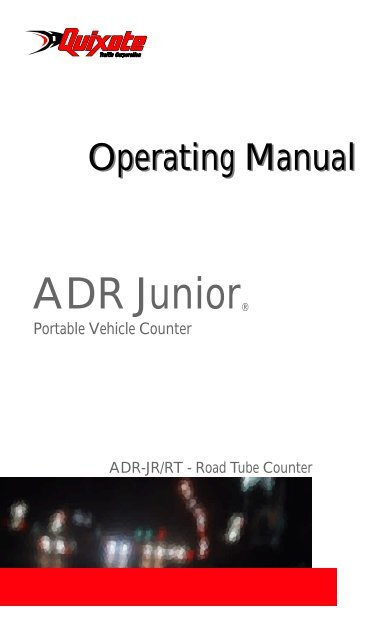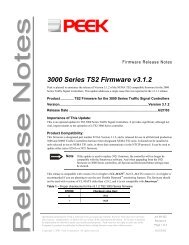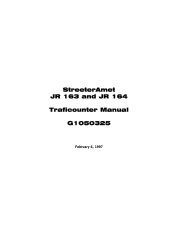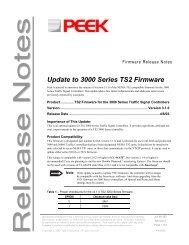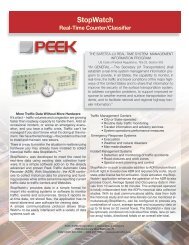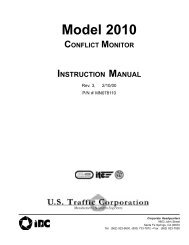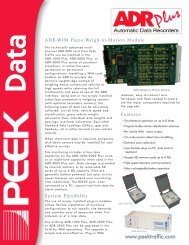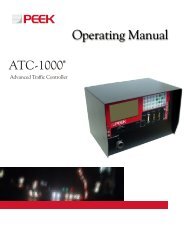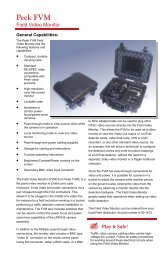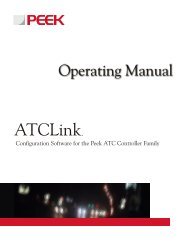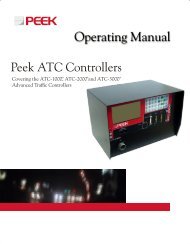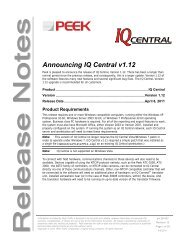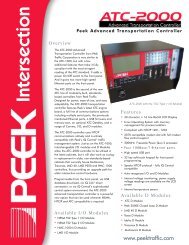ADR JR Operating Manual.pdf - Peek Traffic
ADR JR Operating Manual.pdf - Peek Traffic
ADR JR Operating Manual.pdf - Peek Traffic
You also want an ePaper? Increase the reach of your titles
YUMPU automatically turns print PDFs into web optimized ePapers that Google loves.
<strong>Operating</strong><strong>Manual</strong><strong>ADR</strong>Junior ®PortableVehicleCounter<strong>ADR</strong>-<strong>JR</strong>/RT-RoadTubeCounter
<strong>Operating</strong> <strong>Manual</strong><strong>ADR</strong> Junior/RTPORTABLE VEHICLE COUNTERWITH ROAD TUBE INPUT4/20/2005p/n: 99-406 Rev 2
Contents<strong>ADR</strong> <strong>JR</strong>/RT............................................................................... 1Purpose and Scope.............................................................. 1Assumptions......................................................................... 1Technical Assistance............................................................ 1Features of the <strong>ADR</strong> <strong>JR</strong> Counter.......................................... 2Contents of the <strong>ADR</strong> Junior Kit............................................. 3Quick Start Instructions ........................................................ 4Installation............................................................................ 5Using the <strong>ADR</strong> <strong>JR</strong> <strong>Traffic</strong> Counter...................................... 10Using the Interface......................................................... 10Running a Study............................................................. 14Maintenance & Troubleshooting......................................... 15Notes.................................................................................. 18Glossary ................................................................................. 19<strong>ADR</strong> Junior <strong>Operating</strong> <strong>Manual</strong>iii
Table of FiguresFigure 1 – <strong>ADR</strong> <strong>JR</strong> Kit (<strong>ADR</strong> <strong>JR</strong>/LP shown)......................3Figure 2 – Tube clamp from the <strong>Peek</strong> Roadtube kits ........6Figure 3 – Figure 8 anchor on tube far end.......................6Figure 3 – an <strong>ADR</strong> unit Installed in the field ......................8Figure 4 – Counting multiple lanes withone-input counters........................................9Figure 5 – Navigating the <strong>ADR</strong> <strong>JR</strong>/RT displays...............10Figure 6 – Main Counter Display.....................................10Figure 7 – Study Period display (3 day study shown)......11Figure 8 – Question: Do you want to start a study?.........11Figure 9 – Debounce display...........................................12Figure 10 – Battery Status display...................................12Figure 11 – Advanced display.........................................13Figure 12 – Low Battery Warning display........................13Figure 13 – Low battery indicated on Main display..........13iv<strong>ADR</strong> Junior <strong>Operating</strong> <strong>Manual</strong>
<strong>ADR</strong> <strong>JR</strong>/RTPurpose and ScopeThis manual introduces the <strong>ADR</strong> <strong>JR</strong> portable trafficcounter. It describes how the product is shipped andused, as well as the onscreen interface. It also providesinstructions for repair returns.AssumptionsThis manual assumes that the reader is a qualified traffictechnician and is locally qualified to perform trafficcounting studies, and is well aware of the public andpersonal safety issues that exist when working in such anenvironment.Technical AssistanceIf you need assistance or have questions related to theuse of this product, call Quixote <strong>Traffic</strong> Corporation’sCustomer Service Group for support.Contact InformationToll free in the U.S.: (800) 245-7660phone: (941) 845-1200fax: (941) 845-1504email: tech.support@quixotecorp.comHours ofOperationM-F, 8am-5pm,Eastern StandardTime<strong>ADR</strong> Junior <strong>Operating</strong> <strong>Manual</strong> 1
Features of the <strong>ADR</strong> <strong>JR</strong> CounterThe <strong>ADR</strong> <strong>JR</strong>/RT <strong>Traffic</strong> Counter, from Quixote <strong>Traffic</strong>,provides a simple way to gather count data from a singleroad tube. Its key features are described below.<strong>ADR</strong> <strong>JR</strong>/RTSupremely simple set-upAccurate traffic countsCount totals are axle counts divided by 2Digital 16×2 character back-lit displayRugged, lightweight, self-contained and portableGasketed outer casing is fully splash proofTwo-state, user-selectable signal debounce settingUser-selectable study periods:Half dayOne dayTwo dayThree dayFour dayFive daySix daySeven dayNonstop (continuous)Takes a single road tube inputSolid-state componentsLong battery life2 <strong>ADR</strong> Junior <strong>Operating</strong> <strong>Manual</strong>
Contents of the <strong>ADR</strong> Junior KitThe <strong>ADR</strong> Junior portable traffic counter is shipped with aninstalled 6V battery, a padlock, and this manual.Figure 1 – <strong>ADR</strong> <strong>JR</strong> Kit (<strong>ADR</strong> <strong>JR</strong>/LP shown)To operate in the field, a road tube must be installed atthe site for the <strong>ADR</strong> <strong>JR</strong>/RT. A chain or lock cable is alsorecommended for field operations. These optional itemscan be ordered from Quixote <strong>Traffic</strong>. (See page 17.)NoteThe lid of the <strong>ADR</strong> <strong>JR</strong> displays the productname of the ‘<strong>JR</strong> Traficounter StreeterAmet’.This is thanks to the <strong>ADR</strong> <strong>JR</strong>’s legacy as thesuccessor to the Traficounter products thatwere originally supplied by the StreeterAmetcompany. StreeterAmet was one of thecompanies that were combined to create themodern Quixote <strong>Traffic</strong>.<strong>ADR</strong> Junior <strong>Operating</strong> <strong>Manual</strong> 3
Quick Start InstructionsThe <strong>ADR</strong> <strong>JR</strong> is very easy to set up and operate. To beginusing the counter, unpack the device from its shipping boxand follow these steps:<strong>ADR</strong> <strong>JR</strong>/RT Quick Start1. Using a road tube kit, install a tube across the lanewhere you wish to count traffic.2. Secure the <strong>ADR</strong> <strong>JR</strong> in the location using a chain orlock cable and the padlock.3. Attach the road tube to the <strong>ADR</strong> <strong>JR</strong> single input onthe side of the unit.4. Open the lid of the <strong>ADR</strong> <strong>JR</strong> and touch any of thebuttons to activate the screen.5. Verify that the counter is counting up as vehicles goover the tube.NoteThe <strong>ADR</strong> <strong>JR</strong>/RT is a ‘Divide by 2’ counter,meaning that it increments its vehiclecount by one for every second axle itdetects.4 <strong>ADR</strong> Junior <strong>Operating</strong> <strong>Manual</strong>
InstallationPlacing the <strong>ADR</strong> <strong>JR</strong> in the field for a sampling runinvolves picking a suitable location and installing a roadtube.Hints About <strong>ADR</strong> PlacementThese are some suggestions about the proper place toinstall an <strong>ADR</strong> <strong>JR</strong>/RT for good quality data collection.Select a spot where the road is straight and as farfrom any traffic lights, stop signs, or intersections aspossible.When installing on a highway with a center median,place the <strong>ADR</strong> <strong>JR</strong> in the median. Since most heavytrucks travel in the outside lane, this placement willmake it easier for the counter to detect them.Chain the counter to a tree, sign post, or street lampat the side of the road.Preparing Road Tubes for InstallationBefore installing the road tubes and <strong>ADR</strong> <strong>JR</strong> trafficcounter at a field location, be sure to check the road tubefor dirt and punctures. Also be sure to verify that thebattery has a good voltage level (> 5V, see p.13 fordetails.)No matter where you set up the counter or how manytimes you have set it up, be sure to check the road tubefor cuts, holes, or dirt. Blow the inside of the tube out withan air hose to clear out any debris. The <strong>ADR</strong> <strong>JR</strong> counterwill NOT function properly if the road tube leaks or if it isclogged. Do not use tubes that are shorter than 50’(15.2m) in length, nor longer than 100’ (30.5m) in length.<strong>ADR</strong> Junior <strong>Operating</strong> <strong>Manual</strong> 5
Installing a Tube on a Road Without CurbsPick a location for the <strong>ADR</strong> <strong>JR</strong> counter and secure it. Inthe following discussion, the location of the counter is thenear side of the road.1. Lay the tube across the roadway.2. On the far side of the road, plug the end of the tube.To do this, you can use a ¼”-20 × 1” round-headedscrew, or a ¼” bolt or some other method to blockthe end of the tube to prevent water and dirt fromentering.3. Slide one of the clamps over the end of the roadtube, being sure that the long metal end of the clamppoints away from the roadway. (Or you can opt touse a Figure 8 anchor or a Chinese Finger anchor.)Figure 2 – Tube clamp from the <strong>Peek</strong> Roadtube kitsFigure 3 – Figure 8 anchor on tube far end4. Tighten the clamp around the road-tube (with itsplug screw) using the small screw on the side of theclamp.6 <strong>ADR</strong> Junior <strong>Operating</strong> <strong>Manual</strong>
5. If the ground at the anchoring point is hard, drive aspike through the hole in the metal end of the clampand into the ground.If the ground is too soft to firmly hold a spike, drive astake into the ground instead, and attach the tubeclamp to the stake using a ¼” screw.NoteIf Chinese Finger anchors are beingused to secure the road tube, beaware that if the site tends to causevehicles, particularly large trucks, torun directly over an anchor point, theanchor will damage the tubes andsignificantly shorten their lifespan.6. Return to the near side of the road and slide asecond clamp over the other end of the road tube.(Again, be sure that the long metal clamp end pointsaway from the roadway.)7. Make sure the tube is lying straight across theroadway, perpendicular to the flow of traffic.8. Depending on the hardness or softness of theanchor point on the near side of the road, use thesame anchoring methods that were listed in step 4(using either a spike or a stake.)NoteThe clamp must not grip the tube sotightly that it pinches the tube closed.This would prevent air pulses from theroadway from reaching the sensor onthe <strong>ADR</strong> <strong>JR</strong>. The tube must be able toslide freely through the clamp on thisside of the roadway.9. Pull the road tube through the near side clamp untilit is stretched by ten percent. (i.e. If the roadway is10 feet wide, stretch the tube by one foot, two feetfor a 20 foot wide road, etc.)10. After stretching the road tube the proper amount,wrap enough electrical tape around the road tube<strong>ADR</strong> Junior <strong>Operating</strong> <strong>Manual</strong> 7
next to the clamp so that the tube cannot slide backthrough the clamp.11. If the remaining tube is too short to reach the <strong>ADR</strong><strong>JR</strong> from here, attach a road tube extension sleeve tothe end of the installed tube.If, on the other hand, there is extra tubing betweenthe roadway and the counter, coil the extra length onthe near side of the road next to the counter.12. Slide the end of the road tube over the tube inputnozzle on the side of the <strong>ADR</strong> <strong>JR</strong>/RT.Figure 4 – an <strong>ADR</strong> unit Installed in the fieldInstalling a Tube on a Road With CurbsInstalling a tube on a road that has curbs is the same ason a road without curbs except for the followingmodifications:Because the road tube must be held flat against theroad at all points, the tube must be attached directly tothe roadway on a road with curbs.Do not drive the spike or stake into the ground next tothe road. Instead, look for a crack, expansion joint, ormortar joint in the pavement next to the curb. Drive amasonry spike through the hole in the metal end of thetube clamp and into this gap in the pavement.8 <strong>ADR</strong> Junior <strong>Operating</strong> <strong>Manual</strong>
Counting <strong>Traffic</strong> in Individual LanesIf you want to count the number of vehicles in individuallanes of a multilane highway, but you are using singleinput counters (such as the <strong>ADR</strong> <strong>JR</strong>), place the counterslike this:Figure 5 – Counting multiple lanes with one-input counters<strong>ADR</strong> Junior <strong>Operating</strong> <strong>Manual</strong> 9
Using the <strong>ADR</strong> <strong>JR</strong> <strong>Traffic</strong> CounterThese are some simple guidelines for using the<strong>ADR</strong> <strong>JR</strong>/RT.Using the InterfacePress any button on the top of the counter to activate thedisplay. The battery supplied with the counter will keepthe <strong>ADR</strong> <strong>JR</strong> operating for several years. This is managedbecause the counter has several power conservationfeatures. When a button is pressed, the backlight will turnon for about 10 seconds. Pressing other buttons will keepthe light on. The display itself will stay on forapproximately 30 seconds after the last button is pressed.Whenever a button is pressed, the Main counting displaywill appear. Repeatedly pressing the enter key will cyclefrom Main > Study Period > Debounce > Battery Stateand then back to the Main counting display.Figure 6 – Navigating the <strong>ADR</strong> <strong>JR</strong>/RT displaysMain Counter DisplayWhenever the counter is activated, this is the screen thatappears.Figure 7 – Main Counter DisplayThe left button can be used to reset the counter to000000. It must be pressed and held for at least 2seconds for the reset to occur.The right button will shut off the display (both thebacklight and the text) but the counting will continue.10 <strong>ADR</strong> Junior <strong>Operating</strong> <strong>Manual</strong>
Study Period DisplaysThe study period displays are a set of screens that allowthe operator to select the length of time that a countingsession will last. Use the right arrow button to go up thelist and the left arrow button to go down.Figure 8 – Study Period display (3 day study shown)The order of the studies in the list are:NonstopHalf day1 day2 days3 days4 days5 days6 days7 daysSelect a study by navigating to the desired study periodand pressing enter. If you wish to use the selected periodto start a new study, answer yes to the question thatappears:Figure 9 – Question: Do you want to start a study?Caution Starting a new study will clear thecount of any study that is currentlyrunning.<strong>ADR</strong> Junior <strong>Operating</strong> <strong>Manual</strong> 11
Debounce DisplayDebounce is provided to the road tube sensor inputs todampen acoustic echo within the road tube. Thespeed of this vibration rejection (‘debounce’) determineshow quickly the sensor clears for the next input.Figure 10 – Debounce displayThe debounce setting can be toggled betweenFast and Slow, using the left arrow button.In general, when speeds are slower than 30 mph, setdebounce to Slow. For average speeds above 30 mph,set debounce to Fast. If traffic on the lane is high speedand congested, fast debounce is recommended. This willallow up to 40 axles per second to be counted.Battery Status DisplayThis screen displays the current voltage reading acrossthe battery. This is the value used by the <strong>ADR</strong> <strong>JR</strong>/RT todetermine when to enter the Low Battery state (See page13 for details.)Figure 11 – Battery Status displayAdv - Press the left arrow to display theAdvanced Display. (See page 13.)Press the right arrow button to return to the Maincounting display. (Note that the ENTER button will alsoreturn the display to the Main display.)The battery has a two-year design life, but it may lastlonger depending on environment and usage.12 <strong>ADR</strong> Junior <strong>Operating</strong> <strong>Manual</strong>
Advanced DisplayThis screen is used to display the version of firmwareloaded in the unit, and the number and type of sensorsthat are supported. This window is accessed by selectingthe Adv option on the Battery Status display.Figure 12 – Advanced displayPress the right arrow button to return to the Maincounting display. (Note that the ENTER button will alsoreturn the display to the Main display.)Low Battery IndicatorsWhen the battery voltage drops below 4 VDC, the <strong>ADR</strong><strong>JR</strong>/RT goes into a power saving mode and indicates thecondition in a couple of ways. First, when the counter isactivated, it first displays a low battery warning screen.Figure 13 – Low Battery Warning displayAnd even after this warning screen goes away, the lowbattery continues to be indicated by a ‘B’ in the upper rightcorner of the Main Counter display.Figure 14 – Low battery indicated on Main displayNote that while the counter is in this low battery state, thebacklight for the display will not light.<strong>ADR</strong> Junior <strong>Operating</strong> <strong>Manual</strong> 13
Running a StudyFollow these steps to set up and run a sample study:1. Using a road tube kit, install a tube across the lanewhere you wish to count traffic.2. Secure the <strong>ADR</strong> <strong>JR</strong> in the location using a chain orlock cable and the supplied padlock.3. Attach the road tube to the <strong>ADR</strong> <strong>JR</strong> single input onthe side of the unit.4. Open the lid of the <strong>ADR</strong> <strong>JR</strong> and touch any of thebuttons to activate the screen.5. Press the button to go to the Studyselection screen.6. Use the buttons to navigate and select thelength of time you’d like the <strong>ADR</strong> <strong>JR</strong> to count beforestopping.7. Press the button to select the study period.8. When the ‘Start new study?’ question appears,press the right arrow button ( ) to accept thestudy.9. Press the button again to return to the Maincounter screen.10. Verify that the count is increasing as vehicles goover the tube.11. Press the right arrow button ( ) to turn offthe display.12. Return at any time after the period is finished andpress any button to activate the display. Record thecount from the period.14 <strong>ADR</strong> Junior <strong>Operating</strong> <strong>Manual</strong>
Maintenance & TroubleshootingIf the <strong>ADR</strong> <strong>JR</strong>/RT does not operate correctly, the followingtopics may help.Troubleshooting SuggestionsIf you are encountering problems with an <strong>ADR</strong> <strong>JR</strong>, thefollowing simple steps should be performed to diagnosethe problem.If the unit is off, press any key to see if it will activate.Check to see that the battery is providing at least 4V.Verify that the battery has been connected properly(black to the negative battery terminal, red to thepositive terminal.)If the unit is not counting correctly, try changing theDebounce setting and see if that improves counting.Inspect the tube for any damage. A hole in the tube,or dirt clogging it, can prevent the air pulse fromreaching the <strong>ADR</strong> <strong>JR</strong>.Verify that you are not using a road tube that iseither shorter than 50’ or longer than 100’ in length.Battery CareThe battery included with the <strong>ADR</strong> <strong>JR</strong> is a standard 6Vdry cell alkaline battery that will last at least 2 years.(Depending on conditions and usage, it could lastsignificantly longer.)Replacing the battery is simply a matter of unscrewing theleads from the terminals of the old battery, removing itfrom the <strong>ADR</strong>, inserting the new battery, and attaching theterminal leads. (Red=positive lead. Black=negative lead.)<strong>ADR</strong> Junior <strong>Operating</strong> <strong>Manual</strong> 15
Diagnostic/RMA ProcessThe process to investigate a problem with an <strong>ADR</strong> deviceis quite simple:1. If you are having a problem with your device, contactQuixote Customer Support at (800) 245-7660.2. The customer support representative will attempt todiagnose and correct the problem over the phone.However, if the unit is malfunctioning in some way,you will be asked to return the device to the <strong>Peek</strong>facility for repair. There may be a charge involved.3. The service representative will generate an RMAnumber and fax several RMA labels to you.4. Cut out two of the labels. Firmly attach one of thelabels to the device, and attach the other to theoutside of the return package. The RMA label canfunction as the address label for the box, since itincludes the correct return address.5. Keep one of the extra RMA labels for your records.6. In approximately 5 to 7 days (depending on shippingtime required) contact Quixote <strong>Traffic</strong> to verify thatthe device has arrived. At this time, you may also beable to get a verification of the problem, and an ETAfor repair and return.16 <strong>ADR</strong> Junior <strong>Operating</strong> <strong>Manual</strong>
Optional Accessories/Spare PartsThe following optional components can be ordered from<strong>Peek</strong> <strong>Traffic</strong> and used with the <strong>ADR</strong> <strong>JR</strong>/RT:Table 1 – Optional Accessories for the <strong>ADR</strong> <strong>JR</strong>Component50’ Road Tube Kit (Includes roadtube, clamps, 6” spikes, andmasonry nails)Extra 50’ Road Tube100’ Road Tube Kit (Includes roadtube, clamps, 6” spikes, andmasonry nails)Extra 100’ Road TubeSpare 6V battery<strong>Peek</strong> padlockp/nG1120001G9117202G1120006G9117206G2045270G3018000A4’ chain G9107303-48’ chain G9107303Complete <strong>ADR</strong> <strong>JR</strong> unit 90-175-01For information and to order spare parts, contact theQuixote <strong>Traffic</strong> <strong>ADR</strong> Products sales team at:phone: (941) 845-1200toll free: (866) 260-7335fax: (941) 845-1501email: jturco@quixotecorp.com<strong>ADR</strong> Junior <strong>Operating</strong> <strong>Manual</strong> 17
Notes18 <strong>ADR</strong> Junior <strong>Operating</strong> <strong>Manual</strong>
Glossary<strong>ADR</strong> — Automatic Data Recorder. A device that is installed next to aroadway and which is used to count traffic flows. The more advancedunits can be called ‘traffic classifiers’ because they do more than justcount vehicles, they can also separate them into classes and countvehicles in each class. Advanced <strong>ADR</strong> units can also record PVR (pervehicle record) data such as weight and speed, depending on thetypes of sensors that are available in the roadway.<strong>ADR</strong>-1000 — The <strong>ADR</strong>-1000 is the heart of Quixote <strong>Traffic</strong>’sportable <strong>ADR</strong> product line. The unit comes with four road tube inputsstandard, plus a slot for one additional sensor card which can addeight loop, eight piezo, eight WIM, or fourteen contact-closure sensorinputs. Solar power and PC Card (PCMCIA) options are also availablefor the <strong>ADR</strong>-1000. <strong>ADR</strong>-1000 traffic classifiers can be used withTOPS.<strong>ADR</strong>-2000 — The <strong>ADR</strong>-2000 is a larger version of the <strong>ADR</strong>-1000.Still portable, this unit comes with four standard road tube inputs, butit also provides additional slots for more sensor inputs: 3 sensor cardslots and 1 memory card slot. Can run up to eight classificationstudies at a time, plus gather PVR data. <strong>ADR</strong>-2000 traffic classifierscan be used with TOPS.<strong>ADR</strong>-3000 — The <strong>ADR</strong>-3000 is a rack-mounted version of the <strong>ADR</strong>products. It comes in a 10 inch and a 17 inch wide rack version,expanding the number of sensor and option cards that can beinstalled. The larger unit can accept up to eight sensor input cards,allowing up to 64 channels of input data. Comes with 2MB of onboardmemory for system file and data storage. (Typically, less than 1MB isavailable for data storage on a stock <strong>ADR</strong>-3000.) Options includesolar power, a front panel keypad and display, additional memory, PCCard reader, comm. and modem modules, and a full line of sensorinput cards. <strong>ADR</strong>-3000 traffic classifiers can be used with TOPS, or itcan be accessed using a PDA running Z-Link software.<strong>ADR</strong> Junior <strong>Operating</strong> <strong>Manual</strong> 19
<strong>ADR</strong>-6000 — The <strong>ADR</strong>-6000 is the most sophisticated of the <strong>ADR</strong>products. The <strong>ADR</strong>-6000 uses Idris ® technology to provide highlyaccurate axle count, speed, and vehicle classification data in trafficconditions ranging from high-speed highway flow to stop-and-gocommuter traffic. The <strong>ADR</strong>-6000 data recorder can be used withTOPS.<strong>ADR</strong> <strong>JR</strong> — With the retirement of the <strong>JR</strong> Traficounter, this is thebase model of the Quixote <strong>Traffic</strong> <strong>ADR</strong> product line. It is a simple,battery-powered, one-input traffic counter with a digital display.<strong>ADR</strong> Plus — All newly sold <strong>ADR</strong> units are considered ‘Plus’ versions.The Plus variant was an upgrade to the original <strong>ADR</strong> products thatadded additional memory (raised to 1MB onboard), simplifiedhardware upgrades, improved battery management, and other newfeatures.<strong>JR</strong> Traficounter – The single-input portable traffic counter that the<strong>ADR</strong> <strong>JR</strong> replaces. This was originally designed by a company calledStreeterAmet, which was purchased by <strong>Peek</strong> <strong>Traffic</strong> in 1992. <strong>Peek</strong>was purchased by Quixote <strong>Traffic</strong> in 2004.LP — Loop, an inductive wire loop traffic sensor. Suitable for longtermtesting sites.PVR — Per vehicle records. Data gathered about individual vehiclesthat pass over the <strong>ADR</strong>’s sensors, such as weight and speed.RT — Road tube, a simple rubber tube that can be used to sendpressure pulses to any <strong>ADR</strong> unit that accepts road tube inputs,whenever a vehicle drives over the tube. Suited to short-term studiesbecause of its portability.TOPS — A Windows-based central system software packageavailable from Quixote <strong>Traffic</strong> that allows users of <strong>ADR</strong>-1000, <strong>ADR</strong>-2000, <strong>ADR</strong>-3000, <strong>ADR</strong>-6000, and their ‘<strong>ADR</strong> Plus’ variants to storetheir data in a central location. The software manages the data andcan be used to automate data gathering and to generate datareports and exports. The <strong>ADR</strong> <strong>JR</strong> cannot connect with TOPS.WIM — Weigh-in-motion. A method of measuring the weight of avehicle while it is moving. Available as a plug-in card module for <strong>ADR</strong>-1000, <strong>ADR</strong>-2000, and <strong>ADR</strong>-3000 units.20 <strong>ADR</strong> Junior <strong>Operating</strong> <strong>Manual</strong>
81-1037Quixote <strong>Traffic</strong>Corporation2511 CorporateWayPalmetto,FL 34221phone: (941)845-1200tollfree in the U.S.: (800) 245-7660fax: (941)845-1504email: tech.support@quixotecorp.com


